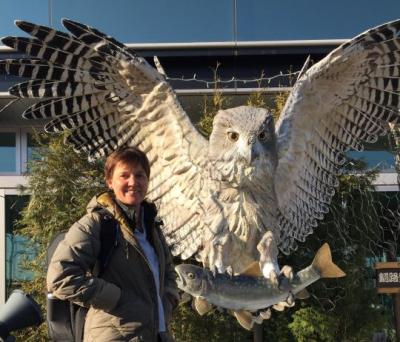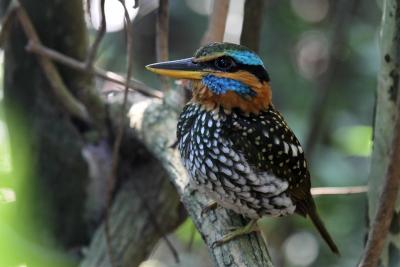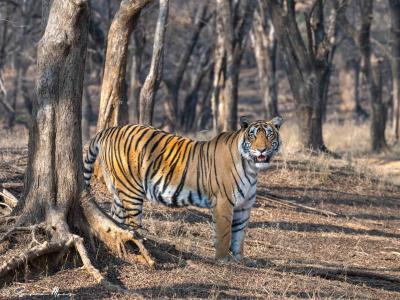Day 1: The tour begins this evening in Denpasar. Night in Denpasar, Bali.
I had been wanting to do an Indonesia tour for a long time, finally got to do it, and it certainly didn’t disappoint. Loved Sulawesi and Halmahera.I’ve been on three tours with Susan. They are always excellent because she handles all facets of a tour in a very efficient and professional manner, from her obvious birding skills, to logistics, planning, etc. I certainly look forward to going on some more tours with her.Gerald Miller, Dec. 2109
Day 2: After breakfast, we’ll transfer to the airport for our flight to Makassar. On arrival, we’ll bird near the airport looking for Barred Buttonquail, Pale-headed Munia, Lemon-bellied White-eye, White-shouldered Triller, Javan Sparrow and possibly Pale-vented Myna. After lunch, we’ll drive to Ramang or Karaenta, remnant forest patches on limestone outcrops close to Makassar and home to our prime target, the very localized Black-ringed White-eye, a species restricted to southern Sulawesi. A number of other Sulawesi endemics also occur, and this morning’s outing will provide an excellent introduction to the island’s magical avifauna. In particular, we’ll keep a keen eye out for Sulawesi Streaked Flycatcher and Sulawesi Dwarf Hornbill, two species that can be hard to come by elsewhere. Sulawesi Babblers (one of the very few babblers to be found east of Wallace’s Line) sing from the undergrowth, noisy Hair-crested Drongos call from the roadside (the distinctive form here has a white eye), and the canopy is home to Grey-sided and Yellow-sided Flowerpeckers and Black Sunbirds, while Grey-rumped Treeswifts patrol above the forest. In open areas near Makassar, depending on water levels in the paddies, we may find such interesting species as Cinnamon Bittern, Woolly-necked Stork, Sooty-headed Bulbul, Pied Chat, Zitting Cisticola, White-breasted Woodswallow, and Scaly-breasted Munia. In the afternoon we’ll bird local fish ponds with another chance at finding Pale-headed Munia. Night in Makassar.
Day 3: After breakfast, we’ll fly to Palu, and continue by road to Lore Lindu National Park. This is essentially a travel day but we’ll have a chance to do some birding in paddy fields along the way. Night in Wuasa.
Days 4-6: This wonderful area supports most of Sulawesi’s montane species and offers fabulous birding. The Anaso Track and the surrounding forest is where most of the montane birds are found, and White-bellied Imperial Pigeon, with its remarkable call, Rufous-throated Flycatcher, Sulawesi Myzomela, and Yellow-bellied White-eye, among others, are possible.
On one day, we’ll walk uphill near the entrance to the Anaso Track in search of Red-eared Fruit-Dove, the rare Sombre Pigeon, flocks of Golden-mantled Racquet-tails, the mysterious Diabolical Nightjar, Maroon-backed Whistler, Pygmy Cuckoo-shrike, the enigmatic Geomalia, Sulawesi Thrush, and the thrilling Great Shortwing. We’ll make a special effort to find the Hylocitrea, formerly known as Olive-flanked Whistler and now in its own family.
On another day we’ll bird at the bottom of the track at Lake Tambing, where the surrounding forest supports still more excitement in the form of flocks of Yellow-and-green Lorikeets, Dark-eared Honeyeater, Rusty-bellied Fantail, and Ivory-backed Woodswallow.
On the remaining day we’ll walk roadsides in excellent forest in search of Piping Crow, Sulphur-bellied Whistler, and Cerulean Cuckoo-shrike, to name but a few. At night we’ll try for nightbirds, including Cinnabar Boobook and Minnahasa Masked Owl. Nights in Wuasa.
Day 7: After breakfast we’ll return by car to Palu, stopping again in the forests of Lore Lindu, and then in Oloboju to look for Savanna Nightjar on its nesting grounds. A number of open-country birds and waterbirds can be seen in the magnificent and ancient paddy fields stretching between the park and Palu. We’ll stop to check through the flocks of Chestnut Munias for the localized Black-faced Munia, and we may well see Lesser Coucal and Eastern Yellow Wagtail. We’ll have a delicious lunch at a floating restaurant on the way, after which we’ll transfer to Donggala and head to Tanjung Karang Beach. Night in Palu.
Day 8: After breakfast we’ll fly to Manado and continue by road to Kotamabagu, stopping for birds along the way. In the afternoon we’ll hope to find one of Sulawesi’s most enigmatic birds, the Maleo, and we have a very good chance of seeing them as they inspect their nests. Maleos lay their eggs colonially in the ground in areas where the soil is heated volcanically, leaving them unattended. The youngsters are able to fly strongly almost as soon as they come out of the egg! Unfortunately, predation, especially by humans, takes a massive toll (almost all the nesting grounds are known to the local people). At this site many of the eggs are taken to be reared in the safety of a hatchery, ensuring a considerably higher success rate than in the wild. Even so, the future of this wonderful species remains precarious. We’ll spend the day in the area searching for Maleo and other forest birds that abound here including an unusual isolated population of Spotted Harrier, Buff-banded and Barred Rails, White-browed Crake, the beautiful Black-naped Fruit-Dove, Sulawesi Black Pigeon, the secretive Yellow-breasted Racquet-tail, Black-billed Koel, Bay Coucal, the colorful Sulawesi Pitta, and Pied Cuckoo-Shrike. Night in Kotamabagu.
Day 9: We’ll bird this morning around Kotamabagu for more views of the remarkable Maleo. If we haven’t seen them yet, we’ll try for Stephan’s Dove, Large Sulawesi Hanging Parrot, Purple-winged Roller, Pygmy Sulawesi Woodpecker, Ivory-backed Wood-swallow, and Yellow-breasted Racquet-tail. After lunch, we’ll drive to Tapakulintang, in Dumoga-Bone National Park. This is a great area for a host of Sulawesi’s wonderful forest birds, including Maroon-chinned Fruit-Dove, Yellow-billed Malkoha, and Ashy Woodpecker. With luck, we’ll also find one or more of the park’s scarcer inhabitants such as Sulawesi Ground-Dove or Rusty-backed Thrush. Night in Kotamabagu.
Day 10: After a full morning’s birding again in the forests of Tapakulintang, we’ll turn eastwards and return to Manado in preparation for tomorrow’s flight to Halmahera. Night in Manado.
Day 11: This morning we’ll take a short flight to the island of Ternate, where we’ll board a speedboat over to the town of Sidangoli on Halmahera. We’ll spend the day birding around Sidangoli before heading to the town of Binagara. Night in Binagara.
Day 12: This morning we’ll bird in the Atakajawe Lolobata National Park near Binagara. In the afternoon we’ll drive to the village of Subaim for a four-night stay. The Foli area to the north of Subaim was made famous in David Attenborough’s film on birds of paradise as the location of one of the display trees of the magnificent and rare Wallace’s Standardwing. This extraordinary bird of paradise occurs only on Halmahera and neighboring Bacan. Until its rediscovery in the 1980s, it was long thought to be extinct, and it is the prime reason for visiting this site. We’ll spend our time searching for the many Halmahera endemics that occur here, including the voluble Ivory-breasted Pitta, which can be found in good numbers. We’ll also do some night birding to find the strange Moluccan Owlet-nightjar, as well as Moluccan Scops Owl. Night in Subaim.
Days 13-14: This morning we’ll leave very early for the drive to Foli, when we arrive we must transfer to a 4WD vehicle for the rough but short drive up the hill to the site of the lek. Waiting under the Standardwing’s lekking tree at dawn, we’ll hear the loud display calls as the first glimmers of light appear through the canopy. As the sun rises, the activity rapidly increases, and gradually our monotone surroundings will be enlivened by flashes of glistening green breast-shields and orange legs. Before we know it, we’ll be engrossed in the spectacular display going on just a few meters above us. Males, with white standards sticking out in all directions, call loudly and suddenly leap into the air before parachuting back down to their perches in the hope of attracting a rather drab female. When one appears, she causes a near riot as rival males tussle over her attention. Its wolf-whistle-like calls echo around the forest, and before too long we should be able to track down this most impressive species. Other hoped-for species include Variable Goshawk, Dusky Scrubfowl, Scarlet-breasted, Blue-capped, and Grey-headed Fruit-Doves, Spectacled, Cinnamon-bellied, and Pied Imperial Pigeons, White Cockatoo (still fairly common despite the ongoing forest clearance), Red-flanked Lorikeet, Chattering and Violet-necked Lories (both declining due to trapping), Moluccan Hanging-Parrot, Red-cheeked, Eclectus, and Great-billed Parrots, Goliath Coucal, Blue-and-white and Sombre Kingfishers, Common Paradise-Kingfisher, Purple Roller, Blyth’s Hornbill, Moluccan, Halmahera, and White-bellied Cuckoo-Shrikes, Rufous-bellied Triller, Golden Bulbul, Long-billed Crow, Paradise Crow (actually a bird of paradise!), and Halmahera Oriole—Wallace’s famous friarbird mimic. Nights in Subaim.
Day 15: Making our way back to Sidangoli from Subaim, we’ll have another busy morning of birding on Halmahera in search of Moluccan Starling, Beach Kingfisher, Moustached Treeswift, and any others we may have missed until now. Of course, second and even third looks at many of the fabulous Halmahera endemics will be much appreciated! We’ll then cross back to Ternate, maybe spying Spinner Dolphins or Red-necked Phalaropes en route. After dinner in our lovely hotel, we can look for the endemic Blue-eyed Cuscus, a possum-like marsupial that lives in the surrounding gardens.
Day 16: After breakfast and some morning birding in hopes of North Moluccan Pitta, we’ll drive to the airport from where we’ll fly back to Manado. On arrival we’ll transfer to our vehicles for the three-hour drive to Tangkoko National Park in Sulawesi’s northeast. Night at Tangkoko.
Days 17-18: We’ll have two full days to explore the coastal and lowland forest of this wonderful park, which supports a good range of the region’s endemic birds. As we travel into the park we’ll bird the forest en route and should see many spectacular Wallacean species, such as Black-naped Fruit-Dove, the unusual Blue-backed Parrot, Yellow-billed Malkoha, and Ashy Woodpecker. This park is amazing for kingfishers, and we’ll look for Ruddy, Lilac-cheeked, Great-billed, and the Green-backed Kingfishers, as well as the diminutive Sulawesi Dwarf Kingfisher. The park boasts a healthy population of the remarkable Knobbed Hornbill as well as a unique monkey, Sulawesi Crested Macaque. Weather permitting, during the heat of the middle of one day we’ll take a boat out to an area of mangroves in search of Great-billed Kingfisher and White-rumped Cuckoo-shrike. As darkness falls in the evenings we’ll walk into the forest in search of the amazing Gursky’s Spectral Tarsier; we have an excellent chance of finding (and photographing) these diminutive primates at dusk as they exit from their shelter in the huge fig trees that are a feature of this area. At dusk on another day, we might see the huge, harrier-like Great Eared Nightjar floating over the forest, and at night we have a good chance of finding Ochre-bellied Boobook as well as, perhaps, the rather cute Speckled Boobook and Sulawesi Scops Owl. Nights in Tangkoko National Park.
Days 19-20: We’ll spend the early morning birding in Tangkoko again before heading back towards Manado and up into the highlands of Tomohon above the city. In the nearby Mahawu forest we’ll look for montane species, including a chance of the elusive Scaly-breasted Kingfisher, Sulawesi Blue Flycatcher, Isabelline Bush-hen, Crimson-crowned Flowerpecker among others. We’ll start our birding this afternoon concentrating our efforts on the Scaly-breasted Kingfisher, the star bird of the area. Nights in Tomohon.
Day 21: This morning we’ll head back down the hill to Manado Airport where the tour concludes.
Last updated Feb 01, 2024













































































